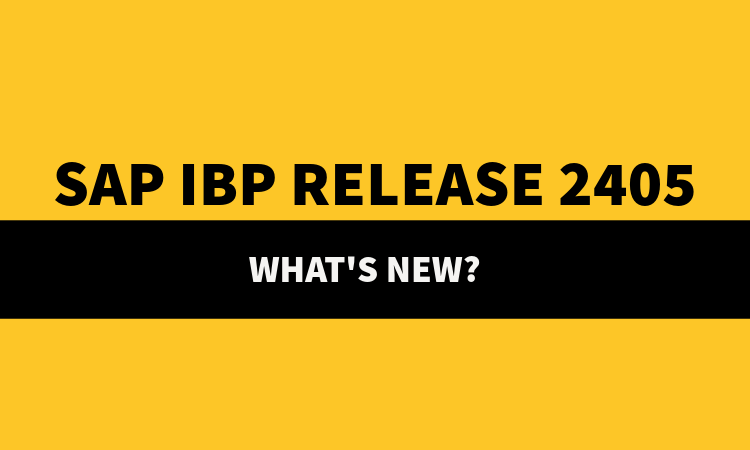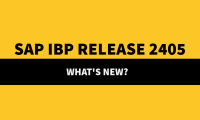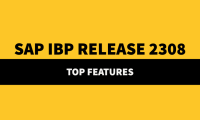
- Changes to Fetching Jobs Data with SAP_COM_0064
Starting from version 2405, there is a change in how application job data is fetched using the SAP_COM_0064 communication scenario. Previously, users could access all jobs, but now only jobs scheduled by the same user are available. To ensure compatibility and access to all jobs, users are advised to transition to the SAP_COM_0326 scenario, which grants access to jobs scheduled by all users. Use the same system and user credentials during setup for a smooth transition.
- New Restriction Type: Scenario Access Scope
In SAP IBP 2405, a new restriction type called Scenario Access Scope is introduced. This restriction type enables users to manage both time-series-based (TS) and order-based planning (OBP) scenarios, including metadata such as owner-user ID and expiry date.
Replacement of Existing Restrictions: The new Scenario Access Scope replaces the Response Management Scenario Instances restriction type and the Scenario value of the Administration Functions restriction type. Although the old restrictions will still be visible, they will no longer control scenario authorizations.
Effects on System Administration:
- For OBP scenario management, it replaces the Response Management Scenario Instances restriction. Users can specify whether all scenarios can be edited or only those created or shared with them.
- For TS scenario management, it replaces the Scenario value of the Administration Functions restriction. Existing role authorizations are automatically copied into the new restriction type during the upgrade to 2405, ensuring backward compatibility.
- If a user had no previous authorization for OBP scenarios but had authorization for TS scenarios, their Write access will default to OWN for OBP scenarios.
- Enhancements for Downloading and Uploading a Configuration as a Binary File
In the Planning Areas app of SAP IBP, downloading or uploading a configuration as a binary file now includes additional items:
- Analytics charts
- Custom alert definitions and subscriptions
- Master data checks
A new notification-based process has been introduced to support the download and upload of analytics charts and custom alert definitions. This process allows the file preparation and upload to run in the background, enhancing user experience.
Additional Details:
- When downloading a configuration, analytics charts, custom alert definitions, and master data checks are automatically included. Select them in the Upload Configuration dialog under Other Configuration during the upload process.
- To handle large file sizes efficiently, the download and upload functions have been improved.
- The download process prepares the configuration in the background. Once ready, you will receive a notification, accessible via the Notifications icon in the SAP Fiori launchpad. Click the notification to start the download.
- Similarly, the upload process now operates in the background. You will be notified when the upload is complete via the Notifications section.
These enhancements streamline the download and upload processes, ensuring seamless handling of configuration files with additional objects.
- Enhancements to the Planning Filters App
The Planning Filters app in SAP IBP has been updated with the following new features:
Validating Sharing Assignments:
- When creating or copying a planning filter, a list of users and user groups available for sharing is presented. However, copying a filter may include invalid sharing assignments from previous versions.
- A new “Check” button allows users to validate sharing assignments based on their restrictions. Invalid entries, such as users not allowed by current restrictions or deleted users, are highlighted with warning messages.
Entering Attribute Values:
- Users can now enter attribute values directly, even if they are not available in the system. This feature provides more control over attribute values.
- Values can be entered individually or copied from a list separated by tabs or lines and pasted into the Value field in the Filter Criteria section. Values with only spaces separating them are considered part of the same attribute.
These enhancements improve usability and control in managing planning filters, ensuring accurate sharing assignments and flexible attribute value entry.
- Enhancements of Master Data Checks
Manage custom master data checks more flexibly with the following enhancements:
Copying Master Data Checks:
- Easily create new checks based on existing ones by copying master data checks in the Manage Master Data Checks app. The new Copy button in the list report view streamlines this process.
Exporting and Importing Master Data Checks:
- Export and import master data checks across system landscapes along with other model entities or extension items using the IBP Master Data Check item type in the Export Software Collections app.
Downloading and Uploading Master Data Checks:
- Download or upload master data checks directly in the Planning Areas app, facilitating seamless management alongside other model entities.
Copying Master Data Checks with Planning Areas:
- Copy master data checks along with planning areas by selecting Operations > Copy > Create New with Dependencies in the detailed view of the selected planning area in the Planning Areas app.
Re-validating a Master Data Check:
- Re-validate master data checks that have become invalid due to modifications in the underlying data model or planning area. Use the Validate button in the Manage Master Data Checks app to ensure accuracy.
These enhancements provide greater flexibility and efficiency in managing master data checks, enabling streamlined processes, and ensuring data integrity.
- New OpenAPI Version
The latest version of the OUTBOUND ANALYTICAL DATA MODEL component, 2405.0.0, is now released for planning results extraction. This version introduces enhancements, including a latest version of the VERID column in the IBP_ANALYTIC_ORDER table, allowing for a maximum of 60 characters instead of the previous limit of 4.
- New Algorithm: Automatic Outlier Correction
A new automatic outlier correction algorithm is now available in the Manage Forecast Models App’s Preprocessing Steps tab. When applied to a forecast model, this algorithm leverages machine learning to automatically detect and correct outliers present in historical data.
Additional Details:
- Outliers are historical values lying outside an accepted range, potentially distorting forecast calculations if not addressed.
- The automatic outlier correction algorithm enhances forecast accuracy by detecting and correcting outliers before running forecast algorithms.
- To address the challenge of selecting appropriate outlier detection methods, the algorithm employs a voting mechanism. Multiple algorithms identify outliers, and the values chosen by the majority are corrected.
- The goal is to minimize false outliers and maximize forecast accuracy.
- Once an outlier is identified, the system corrects it using the smoothing method.
Note: The automatic outlier correction algorithm always corrects outliers. If you prefer to retain detected outliers without correction, use the regular outlier correction algorithm and select “No Correction” as the correction method.
- Extended Use of Product Lifecycle Information
Enhancements in SAP IBP now allow for expanded utilization of product lifecycle (PLM) information across demand planning and inventory optimization. A new PLM engine, previously available upon request in version 2402, is now accessible for general planning purposes, pending activation by your administrator.
Key Features:
- The PLM engine evaluates reference products and forecast start dates defined in the Manage Product Lifecycle app during forecasting.
- It facilitates consideration of PLM information in ABC/XYZ segmentation, forecasting jobs, interactive forecast simulation, forecast automation, and curve clustering, even at aggregated levels.
Considerations:
- The PLM engine does not generate missing planning object records, which can affect product assignments and return no values for missing periods.
- Caution is advised when using the engine for products with future forecast start dates.
- Attribute combinations without forecast dates may now be included in forecasting, potentially leading to unintended supply planning activities.
Configuration and Usage:
- Activate the PLM engine by setting global configuration parameters and enabling the Consider Lifecycle Information option in relevant apps.
- Ensure users are assigned appropriately and configure settings for aggregated lifecycle planning if needed.
- Run interactive forecast simulations to understand the impact of PLM information and adjust logging configurations, as necessary.
These enhancements provide a more comprehensive approach to demand planning and inventory optimization by incorporating PLM information into forecasting processes.
- Additional Algorithm for Best Fit Forecast Models
In SAP IBP, the selection of algorithms for Best Fit forecast models has been expanded with the addition of extreme gradient boosting (XGB). XGB is an ensemble machine learning algorithm designed to improve predictions and decision-making for demand planners, particularly in forecasting sales and identifying challenges in inventory or delivery management.
Effects on Configuration:
- Users can either copy the 2405 version of the SAPIBP1 sample planning area or implement these changes manually.
- For detailed instructions, refer to the IBP 2405 for Cross Topics: SAPIBP1 Planning Model Template document.
- New App: Forecast Error Profiles
In SAP IBP 2405, the new Forecast Error Profiles app is introduced to streamline the management of forecast error calculations in inventory optimization. This app replaces the deprecated Manage Forecast Error Calculations app and offers improved usability. We strongly recommend transitioning to the new app, as the old app will be removed from the SAP Fiori Launchpad after 2408.
Key Features and Benefits:
- Enhanced User Interface: The Forecast Error Profiles app features a user-friendly interface for configuring and maintaining error calculation profiles.
- Seamless Transition: All existing profiles created with the old app are available and can be utilized in the new app without any data loss.
Advanced Functionality:
- Export profiles to a spreadsheet for further analysis.
- Save profiles directly to the SAP Fiori Launchpad for easy access.
- Copy and paste rows from the profiles table within or outside the app.
- Customize columns of the profiles table to suit specific requirements.
- Filter profiles by various criteria such as name, editing status, description, and creator.
- View the saved version of a forecast error profile while editing it, facilitating efficient editing and validation.
Action Required:
- Begin using the new Forecast Error Profiles app for configuring and managing forecast error profiles promptly to ensure a smooth transition.
By leveraging the Forecast Error Profiles app, users can efficiently manage forecast error calculations, leading to improved inventory optimization and decision-making processes.
- Ignoring Production and Transportation Demand in Safety Stock
In SAP IBP, two new attributes available in the unified planning area (SAPIBP1) enable users to ignore production and transportation demand in safety stock calculations for location products across the supply chain. This feature allows prioritization of demand streams to ensure sufficient safety stock for critical needs.
Key Details:
- Attribute Usage: Configure the following attributes in the Location Product.
(IBPLOCATIONPRODUCT) master data type to control safety stock calculations.
- IGNOREPRODNDEMANDINSAFETYSTOCK: Set to Y to ignore production demand, default is N.
- IGNORETLANEDEMANDINSAFETYSTOCK: Set to Y to ignore transportation demand, default is N.
- Prioritization: Adjust these attributes to prioritize one type of demand over the other in safety stock calculations.
- Operator Consideration: This feature affects the Global (multi-stage) inventory optimization and Service Level Prediction operators, which consider both production and transportation demand by default.
- Impact on Safety Stock Recommendations: Ignoring both types of demand at a stocking node results in a safety stock recommendation of 0. Inventory operators treat such nodes as non-stocking and adjust lead time values accordingly.
Configuration Effects:
- Users can either copy the 2405 version of the SAPIBP1 sample planning area or manually implement these changes.
- Detailed instructions are available in the IBP 2405 for Cross Topics: SAPIBP1 Planning Model Template document.
By leveraging these attributes, users can fine-tune safety stock calculations to meet specific demand prioritization requirements, enhancing overall supply chain management and inventory optimization processes.
- Improved Integration between Process Management and Microsoft Teams
Enhancements have been made to the integration between process management in SAP IBP and Microsoft Teams, offering increased flexibility and security:
Key Improvements:
- Enhanced Permissions: Users can now configure permissions for the integration to ensure that SAP IBP only accesses necessary information for creating, updating tasks, and assigning new assignees in Microsoft Teams. This customization enhances security and data protection measures.
- Task Separation: Users can keep SAP IBP tasks separate from other tasks in Microsoft Teams by creating a resolute Entra ID, provided their version of Microsoft Teams supports this feature. This allows users to segregate personal or business-critical tasks that are unrelated to SAP IBP. For instance, users may prefer not to synchronize tasks associated with non-relevant business functions with SAP IBP.
These improvements offer users greater control over their task management processes, promoting security, data protection, and organizational efficiency.
- Enhancements for the Master Data Workbook
Version 2405.2.0 of the SAP Integrated Business Planning (IBP) Excel add-in introduces several enhancements and changes for master data workbooks:
Attribute Selection:
- You can now select attributes of related master data types when creating or editing master data worksheets, enhancing visibility and filtering options.
- Filtering for such attributes is possible on the Filter tab using the simple filtering mode.
Deselection of Required Attributes:
- Required attributes can now be deselected, allowing for the review and modification of existing master data entries.
Display of Planning Level Attributes:
- Attributes assigned to the planning level, including non-root attributes, can now be displayed, and changed in planning object worksheets.
Offline Workbook Recognition:
- Workbooks created with version 2405.2.0 or higher are recognized when logging in offline, ensuring seamless access and updates.
Improved Message Display:
- Clearer messages are displayed when saving master data workbooks, indicating if changes have been saved or rejected.
Attribute Name Display:
- The name of the master data type is now displayed in the Master Data Type dropdown list instead of the description, improving clarity.
Message Display on Save:
- The message displayed upon saving master data workbooks has been improved for better understanding of saved changes.
Changes in Attribute Display Names:
- Attribute names are now displayed consistently across all dialogs of the Excel add-in, reducing confusion.
These enhancements offer improved functionality and usability for managing master data in SAP IBP, promoting efficiency and ease of use for business users.
- SAP Analytics Cloud Integration
System administrators now have the capability to establish a live data connection between SAP Analytics Cloud and SAP Integrated Business Planning for Supply Chain (SAP IBP). This integration empowers business users to develop SAP Analytics Cloud models utilizing data from an SAP IBP planning area, enabling seamless consumption of content within SAP Analytics Cloud stories.
Effects on Data Integration:
To facilitate the SAP Analytics Cloud Integration (SAP_COM_0065) communication scenario, administrators must set up a communication system and arrangement.
This integration streamlines data accessibility and enhances analytical capabilities by leveraging the strengths of both SAP Analytics Cloud and SAP IBP.
- Improved Merge Function for Spaces and Pages
In the Manage Launchpad Spaces and Manage Launchpad Pages apps, you now have the convenience of merging spaces or pages simultaneously when creating or copying a new space or page. Previously, this required a separate step to specify the merge ID, but now you can directly add it during creation. Furthermore, the value help now includes predefined spaces or pages, such as those delivered by SAP.
- Improved Attribute Selection for Loading Master Data in Manage Planning Objects App
In the Manage Planning Objects app, loading master data has become more efficient with enhanced attribute selection. Now, on the Load from Master Data screen, you can filter attributes by other attributes of the same master data type. This refinement enables targeted selections, allowing users to streamline their data loading process. For instance, when selecting product IDs, users can now utilize product family or product group filters to narrow down the results in the list.
- Workflow Approval for the Start of Process Steps
In SAP Integrated Business Planning for Supply Chain (SAP IBP), the integration of SAP Build Process Automation now supports approval workflows for the start of process steps. Previously, approval workflows were only available for the completion of process steps. Now, reviewers can approve or reject the initiation of a process step based on specified start conditions.
For instance, if a team is not prepared to begin a particular step, a reviewer can reject the workflow, causing the process step status to revert to “Not Started” until retriggered. Conversely, if approved, the status changes to “In Progress,” and tasks are generated accordingly.
- Algorithm Sequence of Best Fit Forecast Models
In SAP Integrated Business Planning (IBP), the sequence of algorithms in the best fit forecast models has been optimized to enhance clarity and accuracy. The simple moving average algorithm has been positioned as the first algorithm in both forecast models. This adjustment ensures a more straightforward determination of the best forecast by prioritizing the simple moving average when other algorithms do not yield superior results.
This refinement streamlines the forecasting process by providing a clearer path to selecting the most suitable forecast, ultimately improving decision-making and planning outcomes.
- Enhancements to the Supply Chain Dependencies App
The Supply Chain Dependencies app in SAP IBP now includes several enhancements to provide a more comprehensive view of supply chain networks and their connections. You can now visualize supply chain objects linked to other networks through orders, facilitating better understanding and analysis of dependencies for planning activities and master data management.
New Features:
- Order Link Type Display: The Used By and Using tabs now include the Order link type, showing objects connected to other networks via one or more orders.
Added Filters:
- Network ID: Filter analysis to specific networks.
- Networks Linked by Orders: Display objects linked to other networks via orders.
Additional Columns:
- Main Screen: Network ID.
- Object Dependencies Screen: Network ID and Linking Orders.
Removed Column:
- Version / Scenario: Removed from the Object Dependencies screen.
These enhancements streamline supply chain analysis, providing users with deeper insights into network connections and dependencies. They empower users to make more informed decisions when managing master data and planning activities within the supply chain.
- Integrating Data for Sales Order Field Catalogues in the Flexible Planning Area
With the latest update to SAP Integrated Business Planning (IBP), you can now seamlessly integrate several types of data related to sales order field catalogues (SFCs) into the corresponding master data types for order-based planning. This integration, facilitated by SAP Cloud Integration for data services, eliminates the need for manual data maintenance and streamlines the process of populating master data.
Key Features:
- Data Integration: SAP Cloud Integration for data services enables the integration of diverse data types related to sales order field catalogues (SFCs) from SAP S/4HANA or SAP ERP into corresponding master data types in SAP IBP for order-based planning.
- Enhanced Extractors: The /IBP/SALESFIELD_TEXT extractor collects master data for integration purposes. New data flows in the IBP_MD_S4_ERP_OBP_SFC task template facilitate the transfer of collected data to the SAP IBP planning area.
- Target Staging Tables: New data flows populate staging tables in SAP IBP with master data related to various aspects of sales order field catalogues, such as delivery priority, customer group, sales district, item category, and more.
- Attribute Extension: Master data types in the SAP7F sample planning area have been extended with new attributes for description, enabling seamless integration of additional data attributes.
Effects on Configuration:
- The /IBP/SALESFIELD_TEXT extractor is available with SAP S/4HANA, Supply Chain Integration Add-On for SAP IBP support package 26 or SAP ERP, Supply Chain Integration Add-On for SAP IBP support package 29.
- Master data types related to the SAP7F sample planning area have been extended with new attributes for description, facilitating the integration of additional data attributes.
These enhancements simplify the integration of sales order field catalogue data into SAP IBP, providing users with up-to-date and comprehensive master data for order-based planning activities.



